Wikipedia in the Science Classroom
Published online:
Abstract
Despite research suggesting that writing-to-learn exercises (WTL) in the classroom are associated with increased student learning, WTL is still not widely implemented in science courses. To provide our students with a meaningful WTL exercise that also teaches them how to write for the general public, we incorporated the Wiki Education Classroom Program into scientific writing courses at Ohio University. Our objectives for Wikipedia in the science classroom are two-fold 1) inward facing: teaching students how to critically evaluate and write for the general public, and about how the content of Wikipedia is generated and thus how to use Wikipedia more effectively and 2) outward facing: to increase and enhance scientific content. Students are instructed to select research topics of interest within the scope of the course and related Wikipedia articles to evaluate and edit. Evaluations follow the criteria set forth by Wiki Education and are submitted to the talk page of each corresponding article, enabling the public to view student comments and suggestions. Students then edit their articles based on their evaluations and classroom discussions. Our students have contributed to 99 articles, with 1,514 edits and 83,310 words added, and these articles have been viewed over 2.3 million times. Post-course surveys indicated that students found the exercises to be informative and empowered many to make contributions outside of class.
Citation
Sternberger, A.L., and Wyatt, S.E. 2018. Wikipedia in the Science Classroom. CourseSource. https://doi.org/10.24918/cs.2018.14Article Context
Course
Article Type
Course Level
Bloom's Cognitive Level
Vision and Change Core Competencies
Class Type
Class Size
Audience
Lesson Length
Pedagogical Approaches
Principles of How People Learn
Assessment Type
INTRODUCTION
Teaching students good writing practices and critical evaluation skills is essential to any classroom. In recent years, many instructors have moved from traditional, lecture based teaching methods to more active learning curricula (1-3). One such active learning method is writing-to-learn (WTL), where students use writing to both develop a deeper understanding of subject material and hone their writing skills (3). Scientific writing is a major component of undergraduate science education, and WTL exercises have been shown to greatly enhance students' science process skills and engagement with material (4,5). WTL also enables instructors to identify weaknesses in students' conceptual understanding of material and allows students to forge personal connections with the subject matter (6). However, despite evidence that writing assignments promote active learning and greater student performance over traditional lectures, WTL exercises are underexploited in academia, especially in the science, technology, engineering and math (STEM) fields (1,2,7,8).
We originally incorporated Wikipedia into undergraduate and dual-listed undergraduate/graduate scientific writing courses of 20-25 students. These courses include assignments such as abstracts and posters for scientific meetings, literature reviews or manuscripts based on original research, grant proposals and job application packets (Supporting File S1: Wikipedia in the Science Classroom - Course Syllabus). Our initial idea for using Wikipedia stemmed from our desire to provide the scientific writing courses a meaningful exercise to write for the general public. The Wiki Education Classroom Program (https://wikiedu.org/teach-with-wikipedia/) provided a platform to do so. Wiki Education's Classroom Program offers instructors the opportunity to include Wikipedia in their curriculum while providing resources for both the instructors and students to guide them through the process of selecting an article, evaluating the article following Wikipedia standards, and contributing new material and revisions to bolster article structure and content. Through integrating Wikipedia into the scientific writing courses, our students engage in WTL practices with the additional benefits of learning how Wikipedia content is produced and improving scientific articles already on Wikipedia.
OBJECTIVES
Our objectives for Wikipedia in the Science Classroom are both inward and outward facing. First, we want to give students a meaningful education and outreach venue while also instilling in them proper critical evaluation and writing techniques. Students learn how to 1) critically evaluate articles, 2) write for the public, and 3) see how the content of Wikipedia is generated and thus how to use Wikipedia more effectively. As an additional bonus, students increase and enhance scientific articles, many of which are flagged by Wikipedia as needing substantial revision, offering a significant service to the public.
TEACHING APPROACH
The first step to implement Wikipedia in the classroom is for instructors to sign up for Wiki Education's Classroom Program (https://dashboard.wikiedu.org). After creating an account, instructors are assigned a unique web link to a course Dashboard page. The Dashboard contains links to training modules for instructors (https://dashboard.wikiedu.org/training/instructors). It is recommended that instructors complete the training prior to selecting a Wikipedia assignment for their course. The Dashboard page is also where instructors select and refine assignments (Table 1) and track student activity. Once the desired assignment(s) has been chosen, the Dashboard page is used to build a timeline of due dates as appropriate for the course syllabus. This timeline is accessible to students through the same Dashboard link and shows a weekly breakdown of assignments (Figure 1). Wiki Education staff provide office hours, a time for instructors to talk with each other and to members of the Wiki Education Team. They also provide personalized staff support from a Wikipedia Content Expert assigned to each course to answer questions about Wikipedia policy and standards and discuss any problems that may arise.
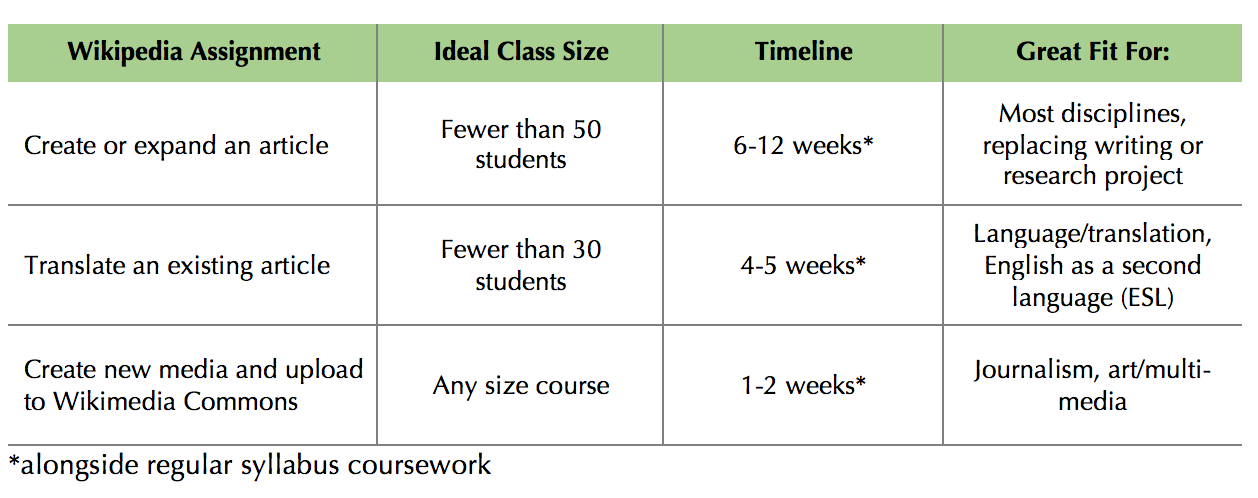
Table 1. Overview of possible assignments offered through the Wikipedia Education Classroom Program. Table was adapted from https:// wikiedu.org/teach-with-wikipedia/.
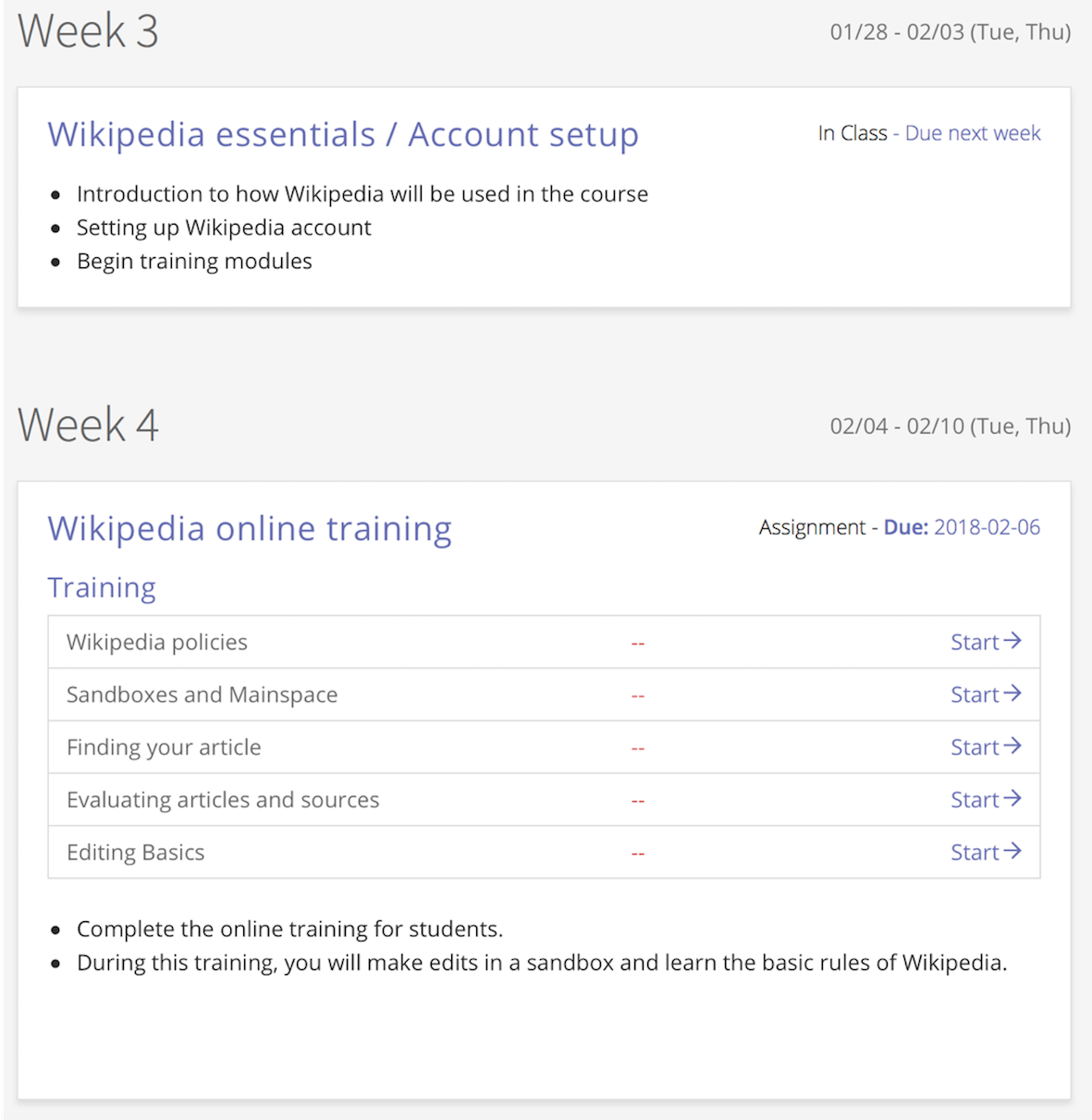
Figure 1. Example of the Dashboard timeline including Wikipedia assignments and due dates for the third and fourth weeks of the 2018 undergraduate scientific writing course at Ohio University.
To introduce the Wikipedia assignment to students, we discuss in-class how Wikipedia will be used in our course, aid students in setting up their Wikipedia accounts through the class Dashboard link, and assign the first student training modules (https://dashboard.wikiedu.org/training/students), which can be aligned to specific weeks in the timeline. The training modules range in length from ~5-25 minutes and familiarize students with Wikipedia and how it will be used. For example, before students evaluate their articles, we have them complete the Wikipedia Essentials, Finding Your Article, and Evaluating Articles and Sources training modules. While it is optional to assign points for student training modules, we found students much more likely to complete the training and be ready to evaluate and edit Wikipedia if points were allotted. We also provide students with links to Wiki Education's Classroom Program resources including online pamphlets for Evaluating Wikipedia (https://wikiedu.org/evaluatingwikipedia), Editing Wikipedia (https://wikiedu.org/editingwikipedia), and Illustrating Wikipedia (https://wikiedu.org/illustratingwikipedia). These resources provide background information on what Wikipedia is and how to navigate it, how articles are created, how contributors improve Wikipedia, criteria dictating how to evaluate article quality, how to edit articles using the VisualEditor and wiki markup, and how to contribute content on Wikimedia Commons, Wikipedia's public domain, media file repository.
For our scientific writing courses, we divide the Wikipedia assignments across the entire semester (Supporting File S1: Wikipedia in the Science Classroom - Course Syllabus). A summary of the Wikipedia assignments are provided in Table 2. Throughout the first seven weeks of the writing courses, writing assignments include producing biosketches and job application packets. During this time, students also familiarize themselves with the Wikipedia resources and training modules and are required to find, read, and critique primary and secondary literature on a topic of their choice. Example topics from previous courses include acid mine drainage, Alzheimer's disease, sustainable landscaping, and tauopathy. The readings guide students in selecting a Wikipedia article to evaluate/edit that best fits their expertise and builds a knowledge base for Wikipedia and other class assignments. Students are now ready to critically review and write an evaluation on their article's talk page (https://en.wikipedia.org/wiki/Wikipedia:Tutorial/Talk_pages), touching on the points listed in the Evaluating Wikipedia resource (https://wikiedu.org/evaluatingwikipedia). Students share their written evaluations (Figure 2) through in-class, small group discussions. During group discussions, students read their peers' article evaluations (on the talk page of the article) and provide verbal feedback. This discussion helps refine and strengthen students' evaluations. After peer review, students revise their evaluations prior to grading. These evaluations form the basis for the editing portion of the Wikipedia exercise due later in the term. While editing, students add content and references, update old and/or unreliable references, remove bias, flesh out content that is already present, and add headings and subheadings to make content more accessible (Figure 3).
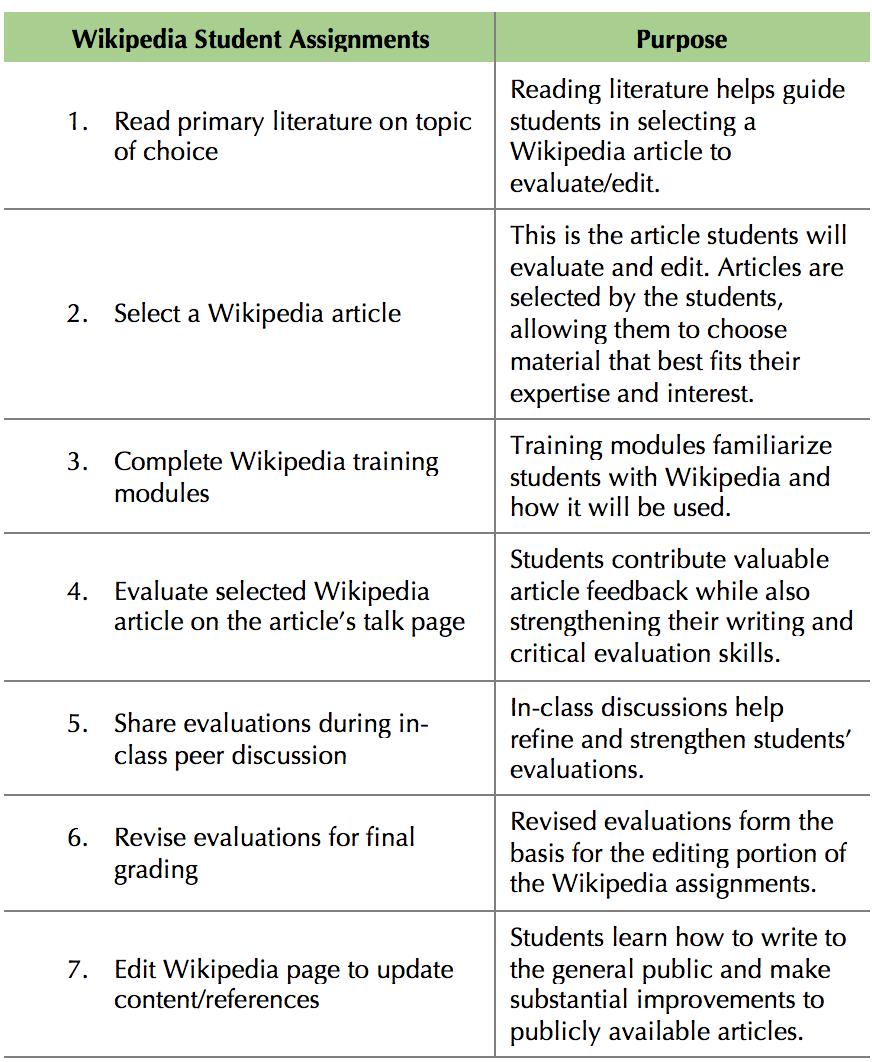
Table 2. Summary of Wikipedia assignments completed by students in the undergraduate and dual-listed scientific writing courses at Ohio University.
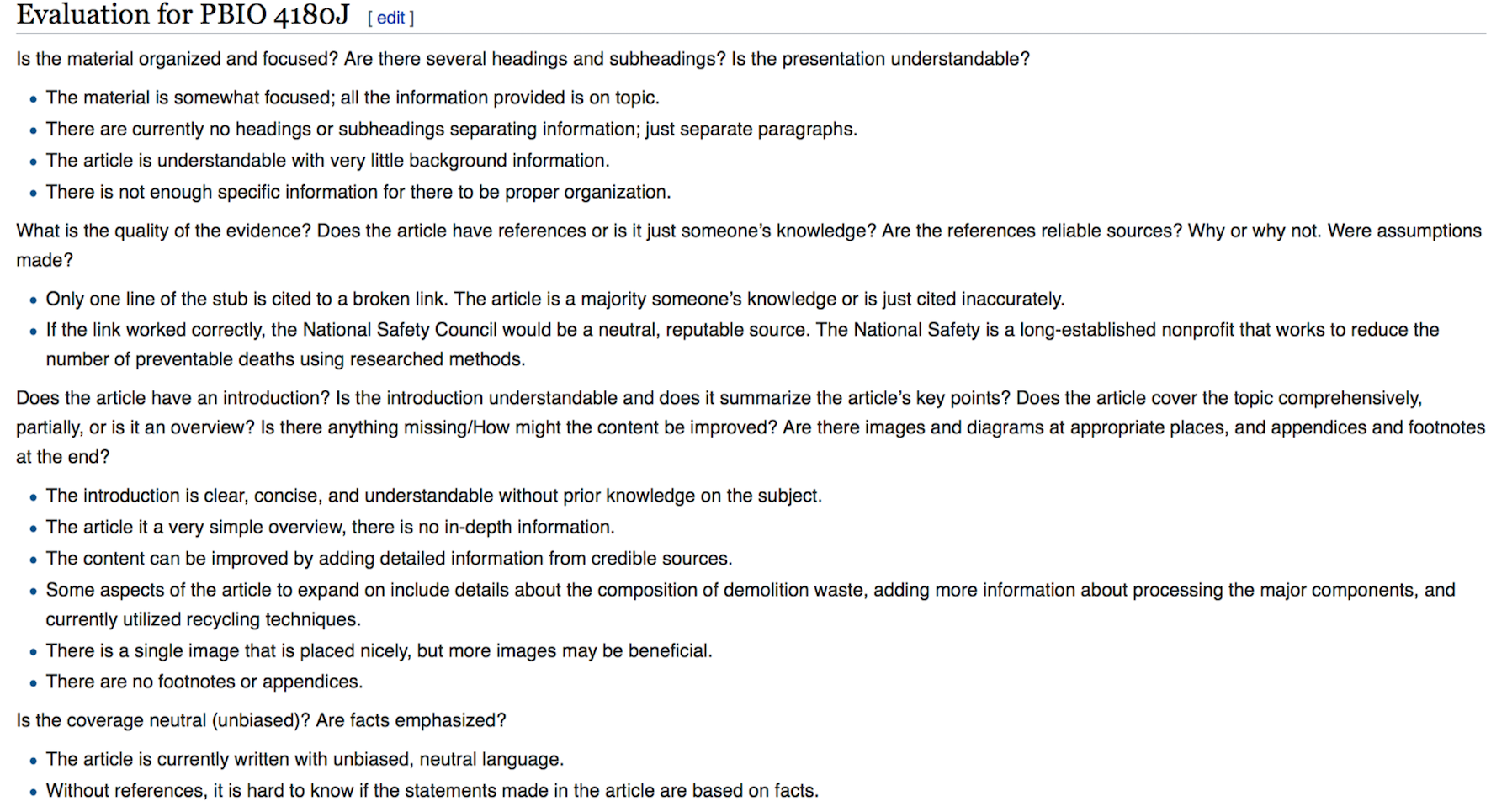
Figure 2. Example of a student’s Wikipedia article evaluation from the 2018 undergraduate scientific writing course at Ohio University. The evaluation is written on the article’s talk page.
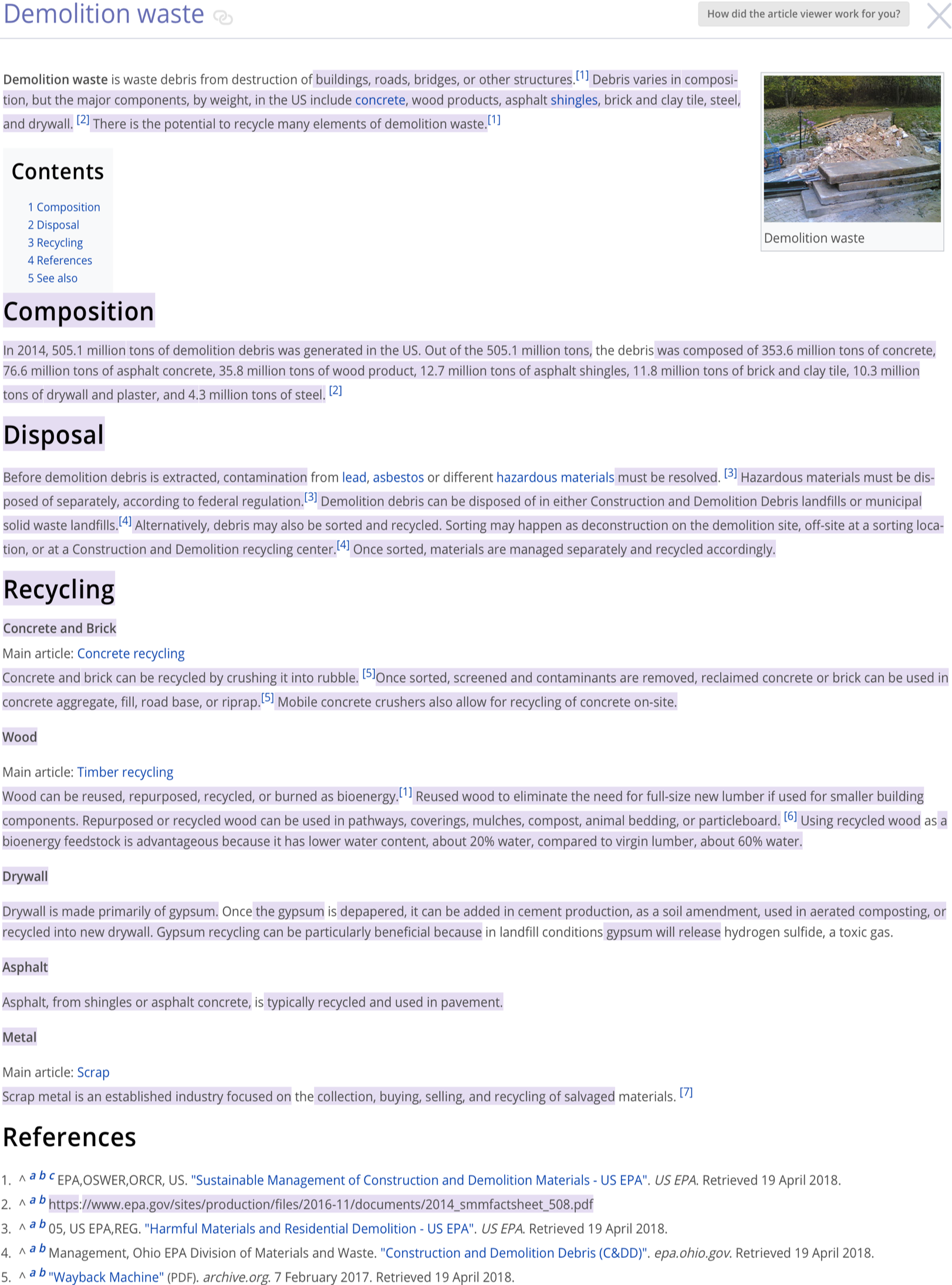
Figure 3. Example of a student’s Wikipedia article edits from the 2018 undergraduate scientific writing course at Ohio University. Text highlighted in purple indicates additions that the student made to the article as seen through the “article viewer” option on the Dashboard page.
Although we use Wikipedia as a writing for the public assignment, evaluating and editing a Wikipedia article as we describe could be substituted for a class assigned, research paper (i.e. short review of a class-assigned or student-selected topic). Wiki Education provides multiple assignments that instructors can select including creating or expanding upon an article, translating into their native language an article from a language that students are studying, and creating original media to upload to Wikimedia Commons (Table 1). We have also explored the use of Wikipedia evaluations in an undergraduate introductory biology course to reinforce and enhance lecture material. Many students in that course are non-science majors, who particularly enjoy and benefit from the WTL science (9,10). Unlike the undergraduate and dual-listed scientific writing courses, students in the introductory course are assigned specific articles that align with lecture material and complete their evaluations as hard copies instead of through Wikipedia (Supporting File S2: Wikipedia in the Science Classroom - Introductory Evaluation Assignment). If students identify significant errors, the teaching assistant or one of the students can correct them on Wikipedia (for extra credit).
ASSESSMENT
Students are verbally assessed by their peers during in-class presentations and discussions of their evaluation and editing process. Students may also be assessed by Wikipedia editors and/or public users that comment on students' work on article talk pages. However, this is not a formal review process, and not every student receives editor or public feedback. For the Wikipedia project, students can earn up to 75 points, and we use a single rubric (Supporting File S3: Wikipedia in the Science Classroom - Assessment Rubric) to assess student performance. The rubric is graded in three parts including 1) getting started, 2) evaluation, and 3) editing. For the getting started portion of the rubric, students are allotted 10/75 points for account set-up, completion of training modules, and selection of an article in a timely manner. The written evaluation of articles (20/75 points) is further split in two parts: assessment of article content and quality. These points are based on how thoroughly the student evaluated the content of their Wikipedia article in the article's talk page (Figure 2). The remaining 45/75 points are apportioned to the editing assignment including the amount and quality, organization, and proper citations of added content. Two subsections provide compliancy checks to ensure that students have presented their content in an unbiased manner (as per Wikipedia policy; https://en.wikipedia.org/wiki/Wikipedia:Neutral_point_of_view) and have completed edit summaries (brief explanations of an edit) as appropriate (https://en.wikipedia.org/wiki/Help:Edit_summary). If not compliant, students cannot earn points for the editing section of the rubric. The rubric was designed using the content presented in the Evaluating Wikipedia and Editing Wikipedia pamphlets. For example, one of the elements of a high quality Wikipedia article is references to reliable sources. Thus, within the evaluation section of our rubric we assign points to how well students have critiqued the article's references. On average, it takes approximately five minutes to grade each student's article evaluation and 10-15 minutes to grade article edits.
PROBLEMS ENCOUNTERED
The Wiki Education Classroom Program provides resources and support to make implementing Wikipedia in the classroom a near effortless process. However, we have encountered a few issues with public editors and/or Wikipedia bots reverting or modifying students' work while students are actively editing. Reversions happen approximately 1-2 times every course, and while this is alarming to students and affects the visibility of their edits in the main article, it does not limit the accessibility of students' contributions, which can still be viewed via the article View History tab. The View History tab allows instructors to assess a student's full editing process and requires little additional effort but is not as user-friendly as the Dashboard's article viewer (as seen in Figure 3) or diff viewer (https://wikiedu.org/blog/2016/11/08/new-feature-view-changes-from-the-dashboard/), both of which are screen displays that show students' cumulative edits without having to leave the Dashboard page.
RESULTS
Over the past three years, we have brought the Wiki Education Classroom Program to five scientific writing classes and an introductory biology course. Students in the scientific writing classes have contributed to 99 different articles, with 1,514 edits and 83,300 words added (Table 3). These articles have since been viewed by the public over 2.3 million times. Additionally, students have contributed 23 original media (pictures, figures, etc.) to Wikimedia Commons. For the introductory biology course, we are currently working on an assessment method to measure student attitude and understanding/retention of lecture material both before and after completion of the Wikipedia evaluation assignment. A formal assessment will allow us to better gauge the effects of the Wikipedia assignment on student learning. Regardless of the course, the Wikipedia assignments are repeatedly mentioned in student post-course surveys as a favorite, and many students have continued to make contributions to Wikipedia content outside of the classroom.
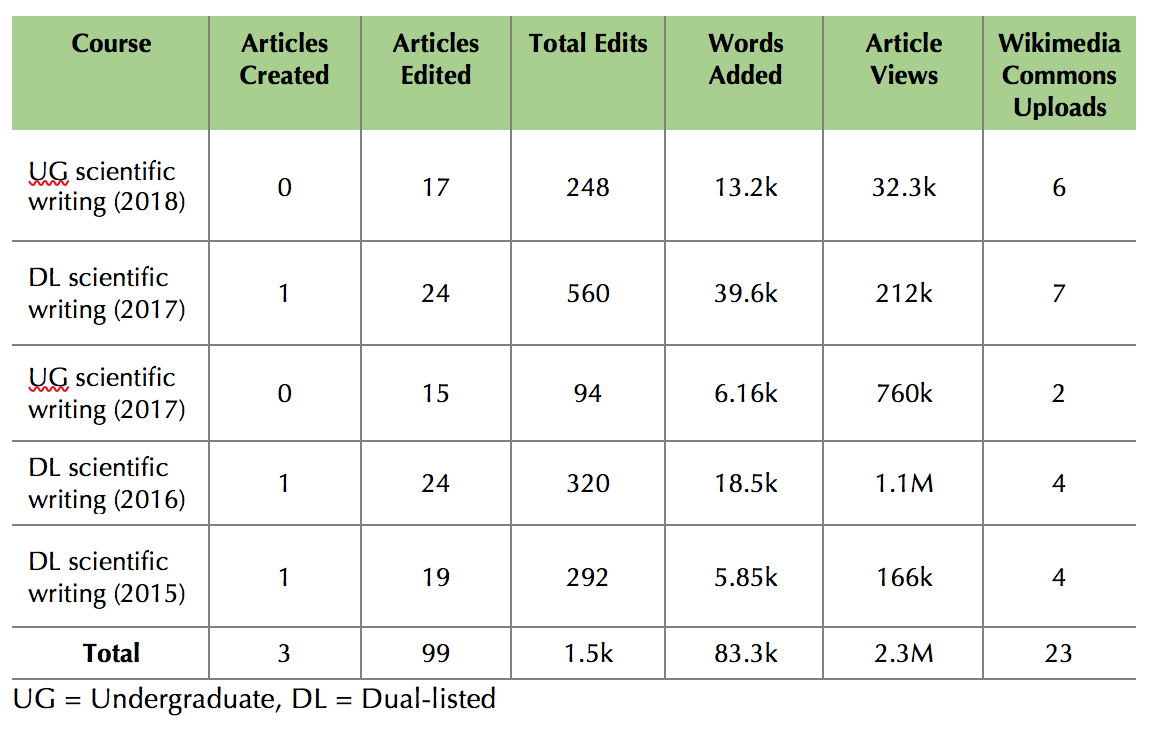
Table 3. Wikipedia contributions of students in Ohio University scientific writing courses, 2015-2018.
CONCLUSIONS
Although WTL promotes active learning and accelerated student performance, WTL methods are underexploited, particularly in STEM. Through the Wiki Education Program, our students are provided opportunities to engage in WTL exercises while also learning how to write to the general public. By evaluating and editing their Wikipedia articles, students engage with subject matter on a deeper level and strengthen their writing, science processing, and critical evaluation skills. Students also learn how Wikipedia content is generated and contribute to the public by improving scientific articles. Incorporating Wikipedia into the classroom is an excellent way to expose students to WTL in a user-friendly, impactful manner, and the Wiki Education Program provides all of the necessary resources to do so.
SCIENTIFIC TEACHING THEMES
ACTIVE LEARNING
Students are actively involved in evaluating and revising Wikipedia articles of their choice. This active involvement provides student ownership of material that is publicly available and immediate investment in the writing. In-class activities stress critical evaluation of the text for both writing style and content, use of proper citations, and potential bias of articles.
ASSESSMENT
Initially students work independently to evaluate and ultimately revise an article. Students work not only with the Wikipedia editors but also participate in small, in-class group activities to share their evaluation and editing experiences. Students are then allowed to revise the assignment to incorporate strategies from their peers, strengthening their evaluation and revision of the Wikipedia article and their methods for critical review. Students' work can also be reviewed by the public, who have access to the talk page of each article and article history. Lastly, we evaluate student learning through the rubric based on Wiki Education resources (Supporting File S3: Wikipedia in the Science Classroom - Assessment Rubric).
INCLUSIVE TEACHING
All students take ownership of a topic and an article of their choice. Each student has the flexibility to evaluate and edit an article of his/her choice and share their process with others in the class in peer review and interactive sessions. Students share not only their expertise in a topic but also their process in evaluation and editing to provide shared experiences with the writing process. These types of small, student-led discussions and presentations have been shown to enhance engagement, motivation, and learning of all students (11).
SUPPORTING MATERIALS
- S1. Wikipedia in the Science Classroom - Course Syllabus -course calendar from the 2018 undergraduate, scientific writing course at Ohio University. The course calendar is broken down into both weeks and individual dates of the semester and includes topics for each class, assigned readings, and assignments due (including Wikipedia assignments which are highlighted in orange).
- S2. Wikipedia in the Science Classroom - Introductory Evaluation Assignment -example of the Wikipedia evaluation assignment used in the undergraduate introductory biology course at Ohio University.
- S3. Wikipedia in the Science Classroom - Introductory Evaluation Assignment -rubric we use to assess student performance for both evaluating and editing of their Wikipedia articles. We designed the rubric directly from the criteria set forth by Wiki Education to identify characteristics of a high or poor quality article. Additional points are given for account set-up, article selection, and completion of training modules.
ACKNOWLEDGMENTS
The authors would like to thank the Wiki Education Foundation for providing the platform and resources that allow us to incorporate Wikipedia into our classrooms and to Helaine Blumenthal, Ian Ramjohn, and the Wiki Education staff that assisted us and our students and provided valuable feedback on students' article evaluations and edits.
References
- Reynolds JA, Thaiss C, Katkin W, Thompson RJ Jr. 2012. Writing-to-learn in undergraduate science education: a community-based, conceptually driven approach. CBE Life Sci Educ. 11:17-25.
- Libarkin J, Ording G. 2012. The utility of writing assignments in undergraduate bioscience. CBE Life Sci Educ. 11:39-46.
- Keys CW. 1999. Revitalizing instruction in scientific genres: connecting knowledge production with writing to learn in science. Sci Educ. 83:115-130.
- Moskovitz C, Kellogg D. 2011. Inquiry-based writing in the laboratory course. Science. 332:919-920.
- Holstein SE, Mickley Steinmetz KR, Miles JD. 2015. Teaching science writing in an introductory lab course. J Undergrad Neurosci Educ. 13:A101-A109.
- Balgopal MM, Wallace AM. 2009. Decisions and dilemmas: using writing to learn activities to increase ecological literacy. J Environ Educ. 40:13-26.
- National Research Council. 2000. How People Learn: Brain, Mind, Experience, and School, expanded ed. Washington, DC:National Academies Press.
- Singer S, Smith KA. 2013. Discipline-based education research: understanding and improving learning in undergraduate science and engineering. J Eng Educ. 102:468-471.
- VanDerZanden AM. 2010. Reflective writing as an assessment for student analysis and synthesis ability in a landscape design course. HortTech. 20:668-671.
- Greenbowe TJ, Schroeder JD. 2008. Implementing POGIL and the science writing heuristic jointly in undergraduate organic chemistry-student perceptions and performance. Chem Ed Res Prac. 9:149-156.
- Salazar M, Norton A, Tuitt F. 2009. Weaving promising practices for inclusive excellence into the higher education classroom. In L.B. Nilson and J.E. Miller (eds.), To improve the academy. Jossey-Bass, San Francisco, CA.
Article Files
Login to access supporting documents
Wikipedia in the Science Classroom(PDF | 2 MB)
S1. Course_Calendar.pdf(PDF | 236 KB)
S2. Introductory_Wikipedia_Eval.pdf(PDF | 75 KB)
S3. Wikipedia_Rubric.pdf(PDF | 121 KB)
- License terms

Comments
Comments
There are no comments on this resource.